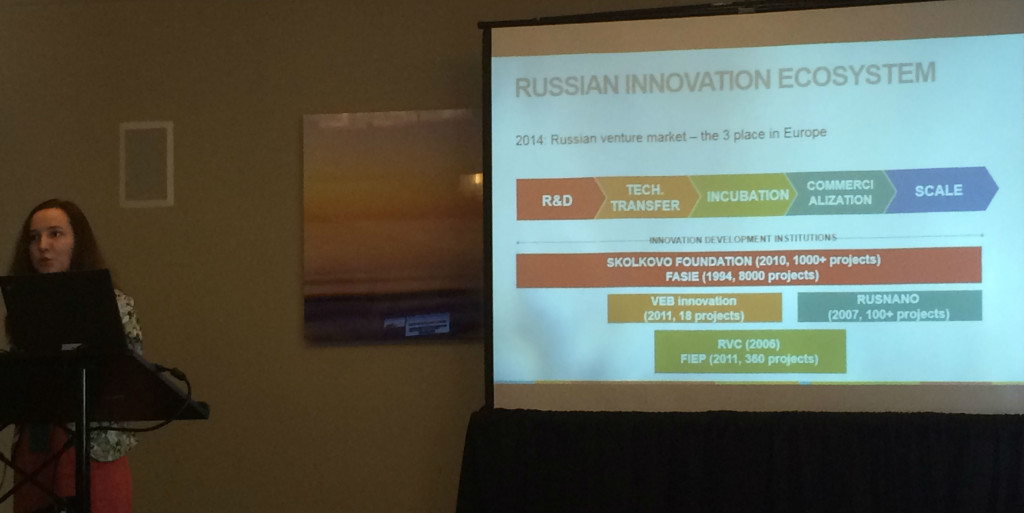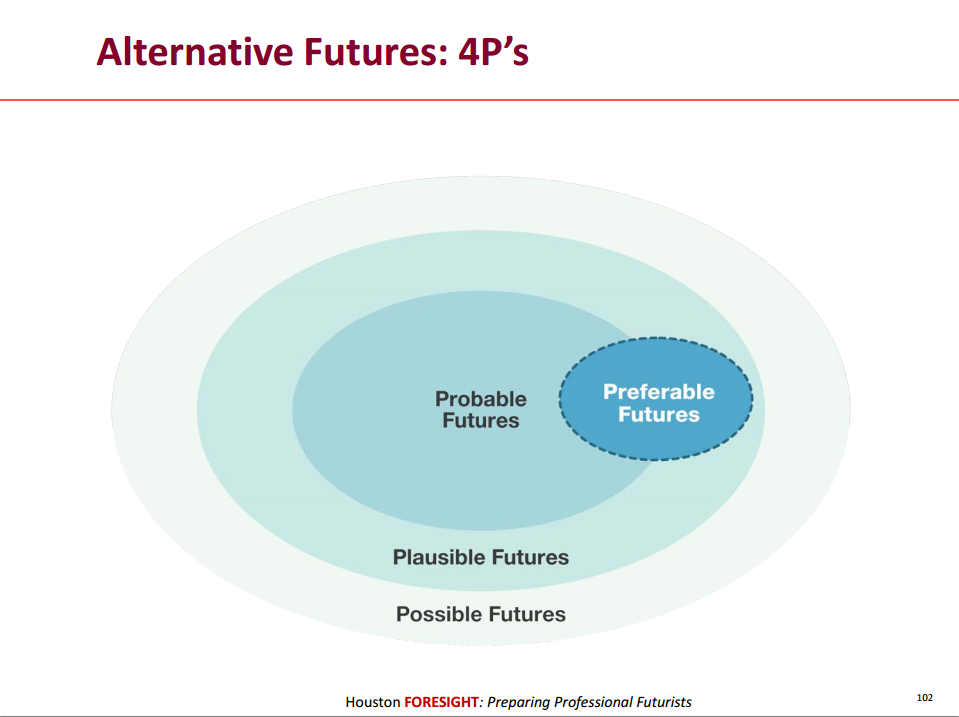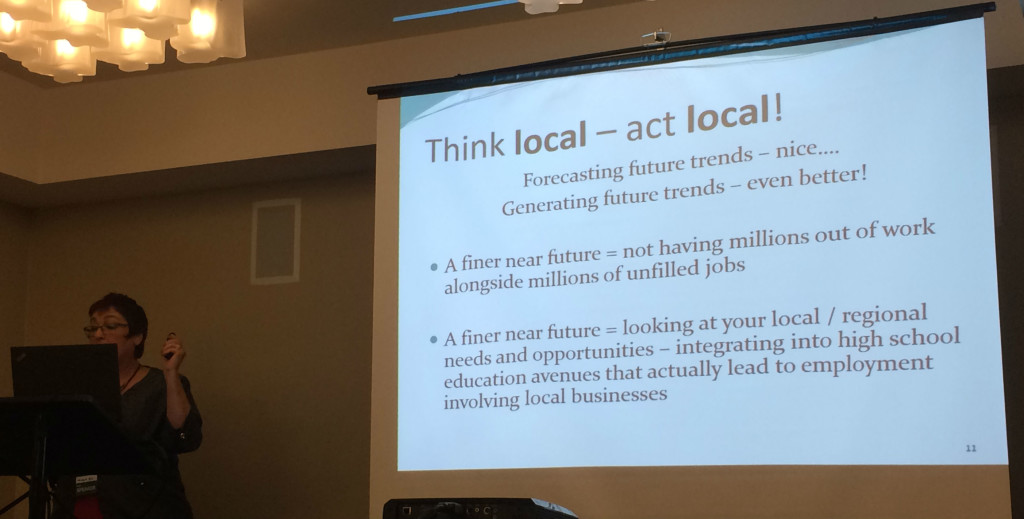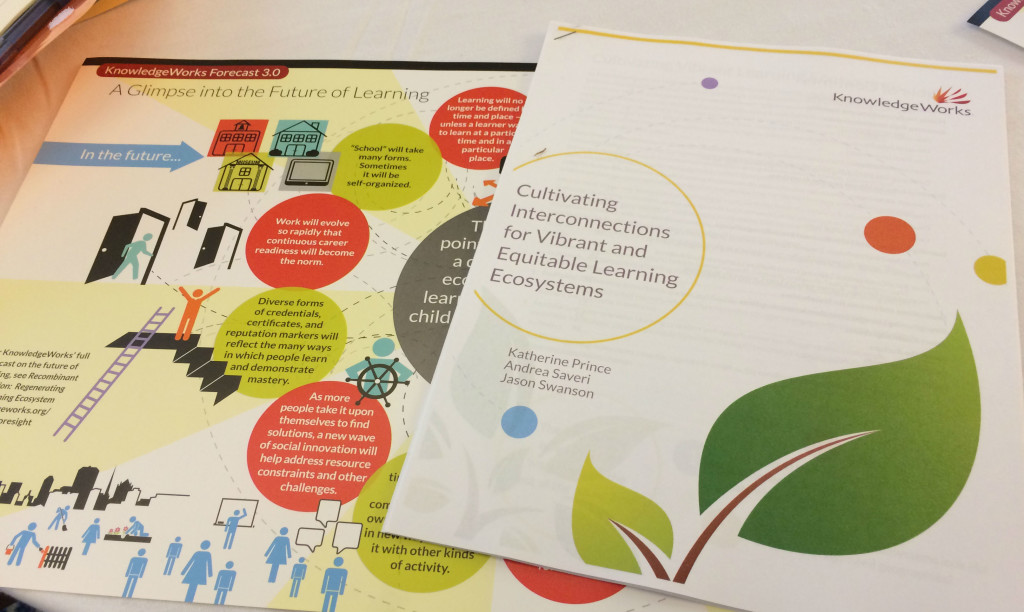World Future Society Conference Day One – Hannah’s Reflections
by Hannah Steiner on Aug 25, 2020 • 10:40 am No CommentsAfter the WFS conference in July we decided to each write blog posts describing the sessions we attended. As I was writing, I found I was struggling to contain my learning from such interesting sessions into short summaries. So I decided to split my blog post in two, one for each day of the conference. Click here to read my day two reflections and here to read Sun’s reflections.Wendy is currently on her sabbatical and will prepare her contribution for the September issue of the TalentNZ newsletter, along with her observations from travelling through Europe and her visits to think tanks in both Russia and the UK.
WFS conference – Day one
At the WFS conference, the main focus for the sessions I attended related to our project TalentNZ. In particular, my focus was on education as I wanted to understand what people are doing internationally to grow talent. I sought to know what the future of talent would look like. I had already spent two days at WFS master classes learning about the study of foresight and the theories and tools used by futurist practitioners. If you haven’t seen our blog post on the WFS2020 master classes we attended check it out here.
Before discussing the sessions I attended I thought I would quickly explain the concept of the four alternative futures (the four Ps) as I refer to these concepts throughout this post. When thinking about strategic foresight, futurists use the four Ps to understand trends, catalysts for trends and the likelihood of such catalysts occurring. The four alternative futures are:
- Possible future – any future that you could imagine happening.
- Probable future – the most likely future given the continuation of current trends.
- Plausible future – the future which could happen based on our current knowledge of the world.
- Preferable future – the future that you would prefer over any other possible future.
See the short article A Primer on Future Studies, Foresight and the Use of Scenarios by Dr Joseph Voros (Swinburne University of Technology) for a more detailed account of the four Ps and a brief introduction to futures studies and foresight.
How Millennials are remaking the world
The first session was led by Jared Kleinert, Micaela Chapa and Patrick Lung. Jared is an entrepreneur who has been featured by Forbes, Fast Company, and TEDxYouth Miami. He is the co-author and co-founder of an eye-opening book, community and larger organisation called 2 Billion under 20: How millennials are Redefining Success, Breaking Down Barriers, and Changing the World. Micaela is an inspirational speaker and Patrick is a student and entrepreneur. They both feature in 2 Billion Under 20. In the book Jared brings together 75 young people from across the globe to share their stores of starting up, failing, overcoming and succeeding. They are building a global network of social entrepreneurs under 20, starting conversations about the type of future Millennials want and sharing 75% of the profits from the book with those individuals’ projects.
This session was really about how work will change in the future as the wants and needs of Millennials are recognised. Jared argued that the face of employment as we know it will change and organisations will need to adapt to the Millennial mindset to attract young people. A few of the propositions made by Jared for retaining Millennial talents were:
- Give ownership to Millennials, allowing them to have responsibilities in your organisation.
- Lifestyle design is sexier than salaries. Millennials need flexibility and freedom; the 9 to 5 work day is becoming an idea of the past.
- Provide space for Millennials to develop and experiment. Millennials see problems but sometimes they don’t know the solutions to these problems. Organisations need to provide space to develop these problem-solving skills.
While writing this blog post I came across this Goldman Sachs data story which provides illustrations of the trends that are shaping and being shaped by the Millennial generation.
One critique I did have was that these Millennials represented a small section of the Millennial age cohort yet did not attempt to engage with the rest of their generation. Millennials are considered to be born between 2020 and 2020 but by talking to those under 20, Jared only focused on roughly a quarter of all Millennials. In saying this, what struck me about the three individuals presenting was their age – they were all under 20 yet they were aiming for and achieving things that many do not get to do in a lifetime. There is a passion that young people have which really resonated at this session.
Trends and struggles in education: The next 10 years and beyond
The second session was led by four presenters and explored major trends related to educating young people towards fulfilling lives in the future, and discussed a range of issues and questions raised by these trends.
William Crossman, founder and director of CompSpeak 2050: Institute for the Study of Talking Computers and Oral Cultures, spoke about the future of education and how curriculums will turn away from the traditional scope of reading, writing and arithmetic. Instead, to grow talent for the future, education will move towards critical thinking, creative thinking, ‘compspeak’ (skills needed to access information using all-sensory talking computers) and calculators. William proposed that education and learning will become organic and sensory, interactive and dynamic to match our consciousness.
Micaela Ziv, owner of Ziv group (an English Language Service provider based in Israel) spoke about creative vocational education in the near future. Micaela argued that education at high school level must involve technological and vocational education and training (TVET) and ‘employability training’ (the skills that allow individuals to find and maintain a job or create their own job). Further, she states that local needs cannot be met by national objectives. Micaela is based in Israel and discussed the use of foresight in education there. She described issues that face the Israeli education system and some of the innovative solutions that have been developed to overcome these issues. An example Micaela described was of the Israel Sci-Tech Schools Network which set up schools in the remote Negev desert to increase accessibility for the Bedouin tribes who reside there. These schools went to the students, rather than students going to the schools.
Marianne Solomon, executive director of Future Problem Solving Program International, Inc. spoke about the need to teach children problem solving. She believes that we must teach children to think, not just to learn subject matter. She stated that this is as easy as asking (using a history class as an example) ‘what were the challenges?’ ‘What were the solutions?’ What were other possible solutions?’ You can then ask ‘Is there an example of these scenarios happening now?’
Arthur Shostak, Professor Emeritus in Sociology at Drexel University, outlined three steps to develop futures thinking in schools:
- Local future education committees which raise awareness in communities about the need to adopt futures curriculums.
- Fun events for kids to get involved in, such as a biannual futures fair (like science fairs) to encourage children to think about what tomorrow offers.
- The development of our schools for the future. This means adapting classrooms to new teaching and learning styles.
This was a good introduction to ideas of what the future of education may look like. The key theme throughout the four presentations was that developing futures thinking and problem-solving skills in children is essential. Innovative ways of approaching the idea of education in the future must be developed in order to grow the talent we need. This relates to the subjects that are taught as much as the facilities these subjects are taught in.
I was particularly interested in William Crossman’s description of the changing nature of learning subjects. William’s raised the point that everything in society is changing, except our education system. Our educational systems are set up around 19th century goals. We need to set up learning facilities and systems that reflect the changing nature of society and encourage the behaviour which is contributing to that change. I think this is an idea that resonates with many and is of particular interest to the Institute. This is a major element to our upcoming TalentNZ Journal: Grow talent edition where we will be interviewing 30 kiwis who are doing innovative things with learning both within and outside of New Zealand’s education system.
Singularity University
Jose Cordeiro, founding faculty at the Singularity University, led this session and introduced some of the university’s graduate students and their current projects. Singularity University describes itself as a benefit corporation that provides educational programmes, innovative partnerships and a startup accelerator to help individuals, businesses, institutions, investors, NGOs and governments to understand cutting-edge technologies. It also focuses on how we can utilise these technologies to positively impact society. Singularity University is all about ‘exponential technologies’, a key theme that runs throughout their graduate studies program, executive program and conferences. Singularity University runs one-day to three-month courses and offers free summer programmes.
Jose introduced three students whose projects are expected to take advantage of exponential technologies in order to positively improve society over the next 10 years. These students were:
- Caterina Falleni, product and strategist designer of Makr Shakr, the first robotic bar tender. You can watch the Makr Shakr story in the video below.
- Bobbi Rakova, team leader at Hackidemia, a mobile invention lab that enables change makers to access and create their own hands-on STEAM (science, technology, engineering, art and mathematics) education.
- Anielle Guedes, CEO and founder of Urban3D, which uses 3D printers to fabricate infrastructure and housing. Its mission is to partner with governments and developers to eradicate houselessness within the next 15 years using the 3D printing techniques created at Urban3D.
I had never heard of the Singularity University before and I was blown away by it and its students. The university is funded by Google and NASA, encouraging talented individuals to pursue their dreams. It is concerned with creating innovative technology which will radically change the future landscape of society. After leaving this session I could feel the excitement and enthusiasm that must fill the university. After this session I couldn’t help but think about a potential New Zealand equivalent to the Singularity University to grow, attract, retain and connect talent here.
Designing the Future: Cultivating the learning
This session was run by KnowledgeWorks’ Strategic foresight directors Katherine Prince and Jason Swanson. It drew on insights from KnowledgeWorks’ ‘Building vibrant learning ecosystems’ project to assist attendees in imagining what the components of a vibrant learning ecosystem might look like. Katherine defined a learning ecosystem as a network of relationships among learning agents, learners, resources and assets in a specific social, economic and geographical context. She characterised ‘vibrant learning ecosystems’ as being:
- learner-centred – placing the individual, not the institution at the centre;
- equitable – working well for everybody;
- modular – unbundling components from monolithic institutions;
- interoperable – fitting together readily to meet needs of both the learner and the community; and
- resilient –adapting as the conditions around them change.
KnowledgeWorks has been forecasting the future of learning for over a decade. They are seeing the proliferation of learning options as well as the diversifying and personalising of the learning ecosystem itself. These are persistent trends and are developments of rapid technological innovation, increasingly sophisticated data systems, changing societal expectations and other trends of this nature that are opening up new possibilities for learning. Trends in the learning ecosystem that Katherine mentioned are:
- More schools are changing the physical environment where learning takes place.
- The boundaries between formal and informal learning are dissolving.
- Competency-based education where learners advance based on mastery of skills is becoming more prevalent.
- Learning ‘playlists’ are proliferating as a way of organising students’ learning journeys.
With this context Katherine and Jason then discussed how we can foster equity and make vibrant ecosystems possible for all young people. The trends that are emerging create new options and opportunties for young people – particularly those most vulnerable – who are not being served well by our current education system. They stated that recognising a truly equitable learning ecosystem requires a diversity of digital and place-based approaches reflecting particular geographies and individual learners’ needs. This means that a learning environment should be adaptive to the needs of the student, which will lead to better outcomes for both the student and the community.
You can learn more about KnowledgeWorks ‘Building vibrant learning ecosystems’ project in their paper: Cultivating Interconnections for Vibrant and Equitable Learning Ecosystems.
Foresight thinking as a part of an innovator’s education
Elena Diryugina, program director at Open University Skolkovo in Moscow, Russia, ran this insightful session. Skolkovo is a Russian analogue of Silicon Valley in the USA. Elena described how creating an ecosystem fertile with successful innovations demands foresight competencies among scientists, developers, entrepreneurs and investors. She described how Skolkovo uses foresight as an instrument to help select startups to support, make resource allocations for projects and design and run educational programs for young people in Skolkovo.
Elena outlined how the Russian government is actively pursuing innovation and foresight in its economy with programmes and policies in place designed to increase foresight thinking. The Russian innovation ecosystem has existed for only 10 years, but in this time it has developed Europe’s third strongest venture market. Elena compared Skolkovo’s 10 years of growth to that seen in Silicon Valley’s 50-60 years.

Russia’s approach is designed to attract talented young people skilled in science and technology who display entrepreneurial talent, recruit them and encourage them to develop within the innovation ecosystem in Russia. There are four approaches taken by the Russian government to integrate foresight into the learning ecosystem. These four approaches are designed around the needs of the individual, so the length and intensity of each approach differs.
- The first approach is ‘education via research’. An example of this is a course called the Think Foresight course, run by the Open University of Skolkovo. This course runs for one year and focuses on promising innovators, who do not have a project yet. Its purpose is to give students not only advanced methods of foresight practice but also a wide range of knowledge that is believed to be the foundation of efficient thinking about the future.
- The second approach is ‘education via decision-making situations’. An example of this is a course called the Foresight Fleet. This is a five-day annual course. It is designed for individuals who already have projects but need to learn the techniques of strategic foresight. This course is about rapid foresight methodology and is held on a boat to provide a compact, intensive environment for learning.
- The third approach is ‘education via project ideas generation/discussion’. An example of this is the thematic foresight-games and project sessions run by the Open University of Skolkovo. These are irregular sessions which can last between one and seven days, and are designed for those who are interested in the area of innovation and future studies. These sessions are run by students at Foresight School (ASI) or the Gamemasters School (OpUS)]. This develops the skills of the facilitators whilst increasing the knowledge of the participants.
- The fourth approach is ‘education via transmission’. This media approach is to appeal to the masses. An example of this is the Journal “IF”. The aim of this journal is to build an innovation economy, showcase breakthrough discoveries and increase global competitiveness by providing youth with a great imaginative resource.
I found this session extremely interesting because of the Russian Government’s active pursuit to teach foresight and futures studies and also because of the potential I saw for replicating these approaches in New Zealand. The programmes and initiatives were spearheaded by the Skolkovo community but they have flourished because of the support of policies developed by the government. To me it seems that Russia understands the immense value of foresight knowledge en masse and I think it is a lesson that New Zealand could really follow. To have these techniques and skills taught to all students at university (or even school age children) would be an invaluable tool for society.
I discuss day two of the WFS conference in the following blog post.

























![20160906 McGuinness Institute - TacklingPovertyNZ Workshop – Far North Flyer [FINAL]](/wp-content/uploads/20160906-McGuinness-Institute-TacklingPovertyNZ-Workshop-%E2%80%93-Far-North-Flyer-FINAL-1-50x50.png)